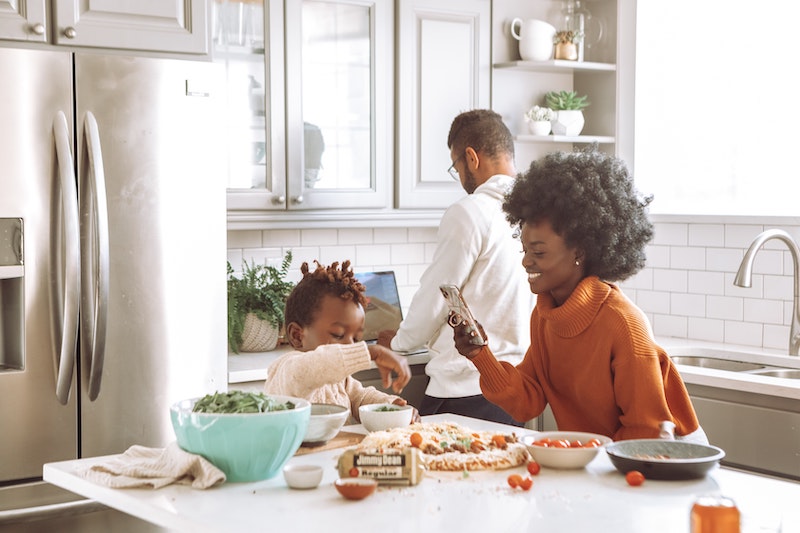Greek-style chicken thighs with bruschetta. Italian steaks and panzanella. Seared tilapia and pickled pepper relish. Menu choices at a trendy, highly-ranked restaurant? No. The final challenge recipes of a reality cooking television show? No. On the contrary, they’re a sampling of the meals my three teens have cooked together during the coronavirus quarantine.
They weren’t thrilled, that first night, about being called out of their comfortable rooms and informed that they were on cooking duty. T.J., my eldest son, looked as if he might politely decline until the expression on my face indicated that it wasn’t a kind offer; rather, it was a firm directive. They stand in a semi-circle as I explain: our normal escapades—travel, performances, get-togethers—have been curtailed this year, for good reason. The bulk of their adventures will take place within these walls. And this is one of them, every Monday from now on. I hand over a recipe from a meal kit delivery service, direct them as to where the ingredients can be found, and leave them to it.
The kids somehow democratically decide on specific roles: T.J. commandeers the protein, generally stove-top; Elias, my youngest, has become the expert at chopping and mincing vegetables; and my daughter Maya deals with sauces, salads, and garnishes, assuming kind of a catchall role, handling the assorted and sundry additional tasks that each recipe calls for.
They occasionally find me to ask minor questions—about recipes that call for a zester or the best method for chopping an onion—but for the most part, they manage to figure it out on their own. Only rarely has the smoke detector gone off. “Olive oil has a low flash point,” I tell them, making a clumsy attempt to explain scientifically what a flash point is. They laugh at this small calamity, grabbing pillows and paper to wave under the machine until it is silenced.
Music plays a big part in this project, their choices consisting of an eclectic mix, with tracks ranging from Khalid to ColdPlay, Erykah Badu to Post Malone, Journey to the soundtrack of Princess and the Frog. While they wait as the water boils for rice or roasted vegetables to brown, becoming crispy and sweet, they show each other dance moves or share something they saw on Tik Tok or YouTube. The atmosphere is jovial, a weekly mini-party.
As the months pass, I suggest they switch roles for variety. They choose not to, and I don’t push it. Each has found a niche. Initially dubious about the cooking expedition, T.J. now approaches me early in the day on Mondays to see what dish they will cook that night, then takes the meat out to thaw. At the designated time, Maya sets up her Bluetooth speaker, and Elias begins gathering the ingredients from the refrigerator and pantry. When the evening’s culinary adventure is complete, their faces glow from both exertion and pride as they present the exquisitely-plated meals.
I am content listening from my home office just off the kitchen, as the combined sounds of laughter, music, and the stove’s blower comprise an orchestra in a class all its own. I am happily distracted from thinking about things I don’t want to think about, things for which I don’t have the answers but so desperately seek. How these beautiful beings will fare after nearly a year of necessary restrictions on movement and fellowship, accompanied by a political atmosphere of strife and acrimony. How they are steadfastly pushing forward with online learning, afforded only the rare in-person interaction with a friend. What life, travel, and exploration will look like for them when the world emerges from the pandemic. Whether the current societal awakening regarding racial issues will be impactful and true, leading to lasting change that positively impacts their lives. Whether there is more that my husband and I can do to mitigate this challenging time’s negative effects. These thoughts are always situated in one of two places: hovering in the background, on the edge of my consciousness, or taking up prime retail space in my mind’s center.
***
At one point during my children’s early years, I signed up for an evening workshop, drawn in by its charming name: “The Sibling Environment—A Laboratory for Love.” As an only child, the experience of the singular bond of intimacy between siblings wasn’t in my repertoire. The possibilities intrigued me. With the proper approach, my brood, as my late father fondly referred to them, could learn and adopt priceless, meaningful skills that would later serve them in both friendship and romance. No matter what life throws at you, “all you need is love,” as the song goes.
The program ultimately turned out to be one of those situations where the title promised much more than it delivered. Most of the couples present had children who were teens, much older than ours were at the time. The concerns of those parents dominated the night, quickly transforming it into a session of rants about catfights and one-upmanship. Their feelings were gently attended to by a kindly-faced psychologist, who solemnly named and acknowledged their frustrations, then sympathetically parroted them back. These experiences portrayed the sibling context as a laboratory for indifference at best, resentment, and rivalry at worst.
Despite the letdown of that evening, the notion of the sibling context as a practice ground for healthy, loving interpersonal skills remained with me. I called on examples from my own family: my grandfather and the closeness he shared with his siblings, all of whom migrated from Mississippi to California with their families for better opportunities during World War II. My mother and her sister, their understanding of each other allowing them to operate almost like twins. My husband and his four siblings, who maintain a close connection despite being separated by thousands of miles. With these examples in mind, we decided that our home would become the perfect locale for a day-by-day offering, a chance for a 24/7 curriculum of sorts on compromise and collaboration, on deriving fun from the mundane and, most significantly, on unconditionally uplifting those closest to you, simply because you see beyond the external to the depths of who they truly are. Living. Loving. Thriving.
***
“Cas-tel-ve-tra-no. Castelvetrano. That’s you how say it.” I hear Elias pronouncing the type of olive he’s chopping as they prepare a salad that will accompany tonight’s dish, Chicken Milanese. I hear sizzling as T.J. pan-fries the chicken that Maya has coated with a beaten egg and panko breadcrumbs. As they cook together, combining and transforming simple ingredients into something greater, I hear the sounds of optimism, adaptability, and good cheer. I fast forward to the future, imagining each of them with their own chosen families, sharing life and love in this same way, having survived these unprecedented times. In my search for answers from outside sources, I realize the answers are right here.
_________
Kimberly Lee left the practice of law to focus on motherhood, community work, and creative pursuits. Her work has appeared in Fresh Ink, Thread, Toyon, The Sun, The Ekphrastic Review, and Calliope, amongst others, including Literary Mama, where she is an editorial board member. She lives in Southern California with her husband and three children.



